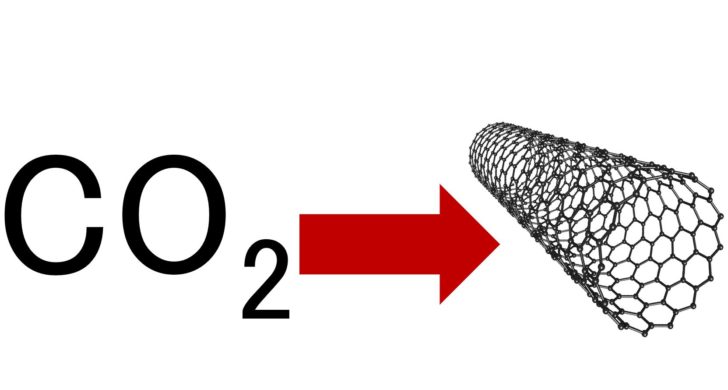Umwandlung von Kohlenstoffdioxid in Kohlenstoffnanoröhrchen

Die Zementindustrie ist verantwortlich für fünf Prozent der globalen Emissionen und gehört zu den grössten CO2-Austoss Quellen. Zwei Drittel dieser CO2-Emissionen werden während dem chemischen Prozess des Brennens von Kalkstein für die Zementproduktion freigesetzt. Diese können nur durch das Extrahieren von CO2 aus den Emissionen reduziert werden. Nun konnten Forscher in zwei neuen Studien zeigen, dass Zementfabriken ihr eigenes Kohlendioxid-Abgas beseitigen können während sie gleichzeitig Nanokohlenstoffröhrchen herstellen.
"We have demonstrated that with our C2CNT (carbon dioxide into carbon nanotubes) process, a wide portfolio of tailored carbon nanotubes (CNTs), such as those with special shapes or conductivity can be made," Stuart Licht, a professor of chemistry at George Washington University, tells Nanowerk.
In the first paper, in Journal of CO2 Utilization ("Transformation of the greenhouse gas CO2 by molten electrolysis into a wide controlled selection of carbon nanotubes"), Licht and his team present the transformation of CO2 into specific, controlled carbon nanotubes.
This study presents a straightforward process that transforms CO2 to carbon nanotubes by molten electrolysis with inexpensive (nickel and steel) electrodes and low voltage. This synthesis consumes only CO2 and electricity, and is constrained only by the cost of electricity.
"Control of electrolysis parameters opens up a wide portfolio of CNT morphologies including hollow or solid, thick or thin walled," says Licht. "Our portfolio also includes doped CNT. Molten carbonate electrosynthesized boron doped CNTs have high electrical conductivity. The CNT from CO2 synthesis remains single step (one pot) in which a specific impurity is dissolved in the electrolyte to achieve a desired doped CNT characteristic."
In the second paper, also in the Journal of CO2 Utilization ("Co-production of cement and carbon nanotubes with a carbon negative footprint"), Licht presents the use of C2CNT to retrofit cement plants.
Cement production today has a massive carbon footprint and simultaneously releases CO2 both from limestone and from fossil fuels, and hence cement plant smokestacks have much higher CO2 content (5 times higher than gas fired electric power plants).
This study compares conventional cement plants to alternative C2CNT cement plants and shows:
· In the C2CNT cement plant CNTs are produced by molten carbonate electrolysis of CO2.
· The conventional cement plant emits 1.1 ton of CO2 per ton cement produced.
· The C2CNT cement plant emits no CO2, converting it to a valuable CNT co-product.
· Per ton CO2 avoided, the C2CNT cement plant consumes $50 electricity, emits no CO2, and produces $100 worth of cement and ∼$60,000 worth of CNTs.
Scaling up the C2CNT process to work with commercial plants is the ongoing second stage of the researchers' investigations. As part of this effort they have advanced to the semifinals of the Carbon XPrize as the C2CNT team. The Carbon XPrize is a global competition for research teams to transform CO2 from a power plant into the most valuable product.
Quelle Artikel: Nanowerk News
Quelle Bild: flickr